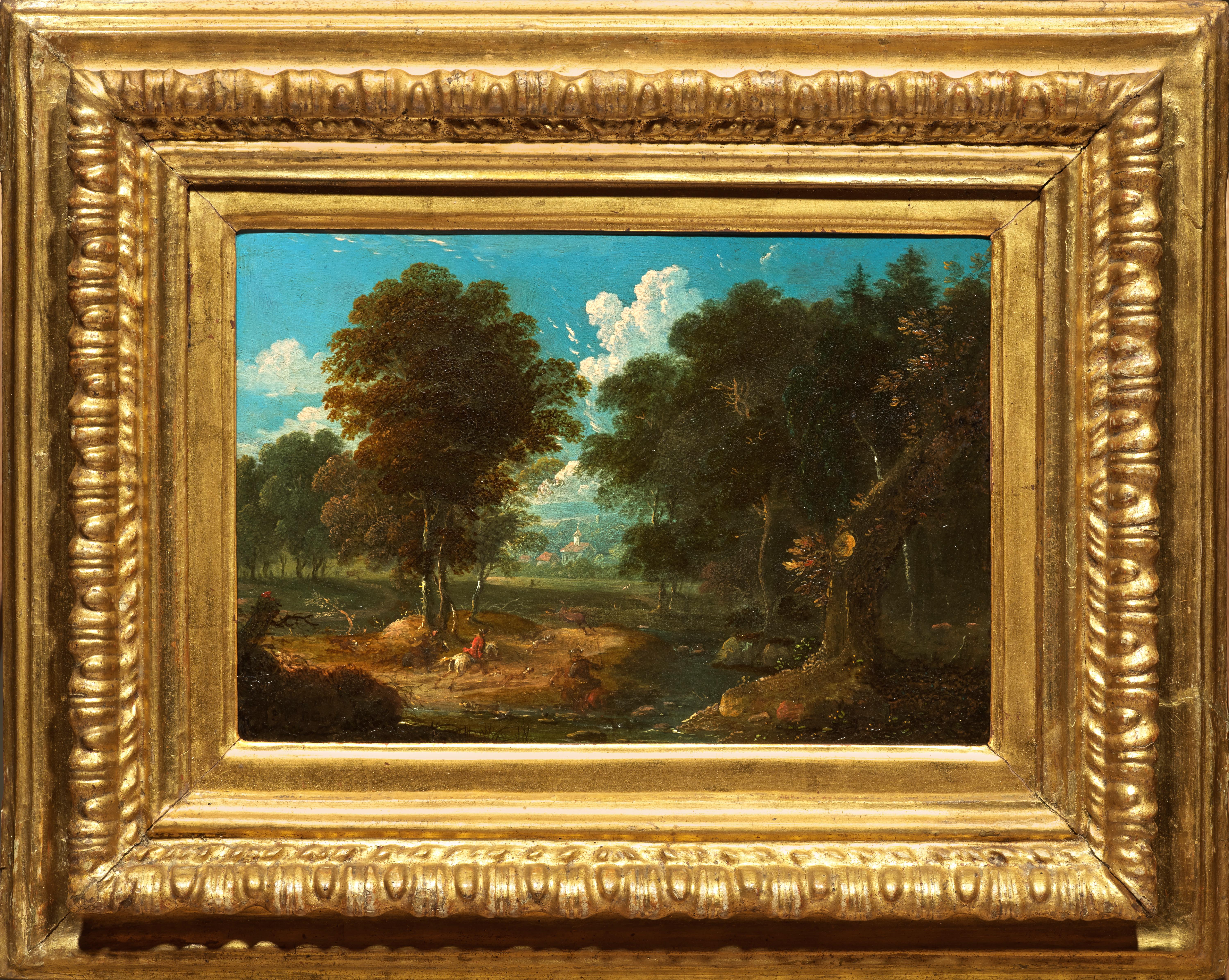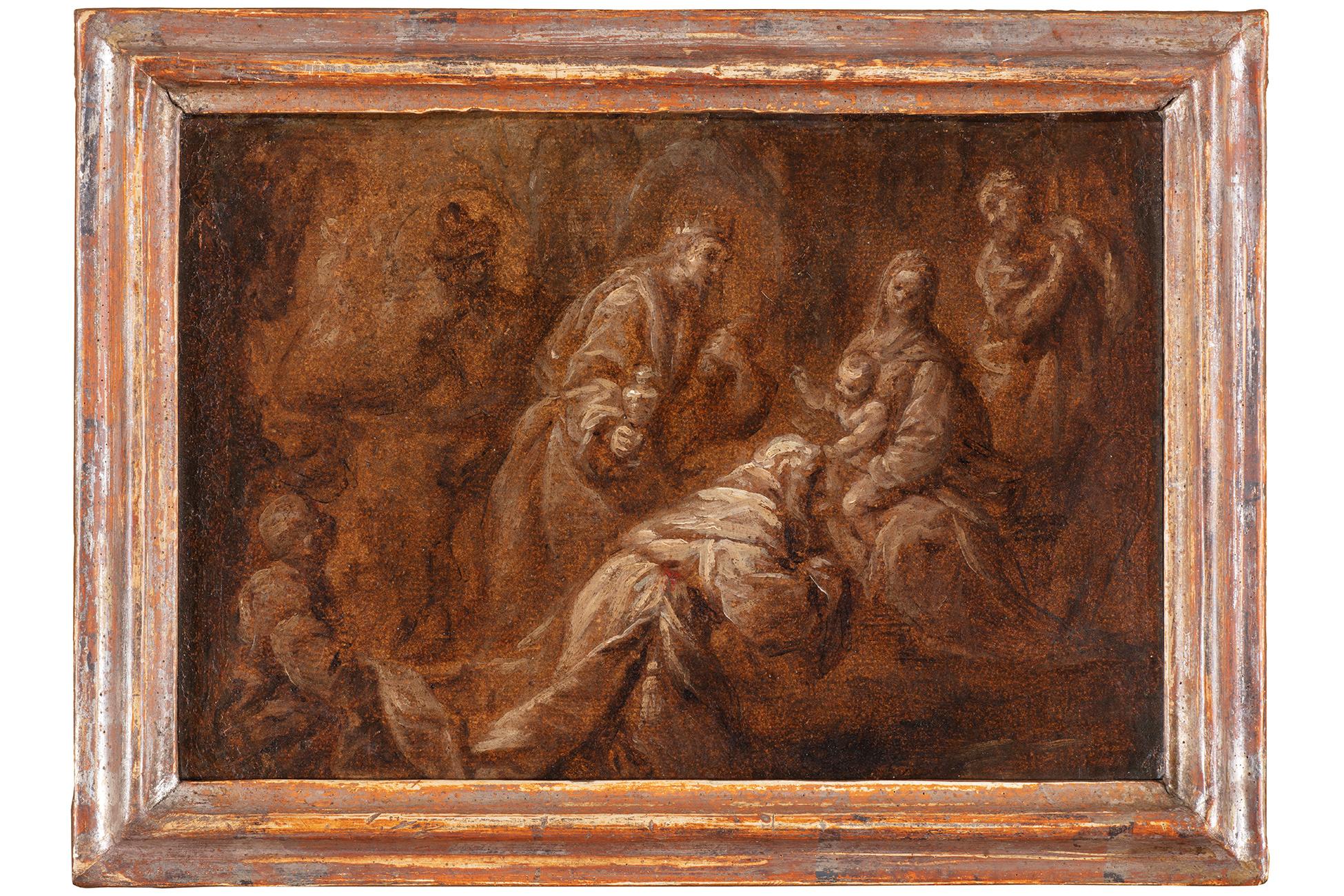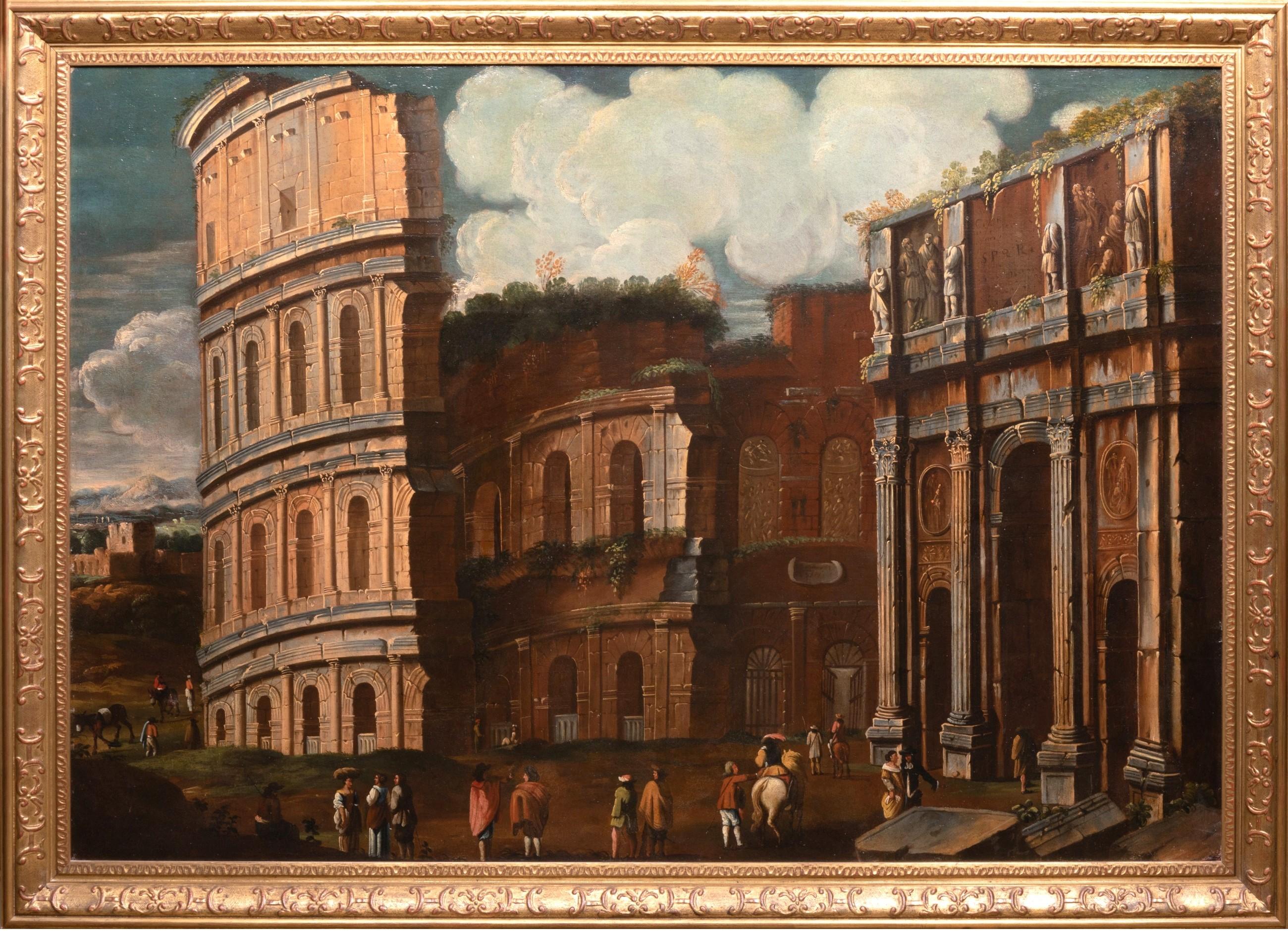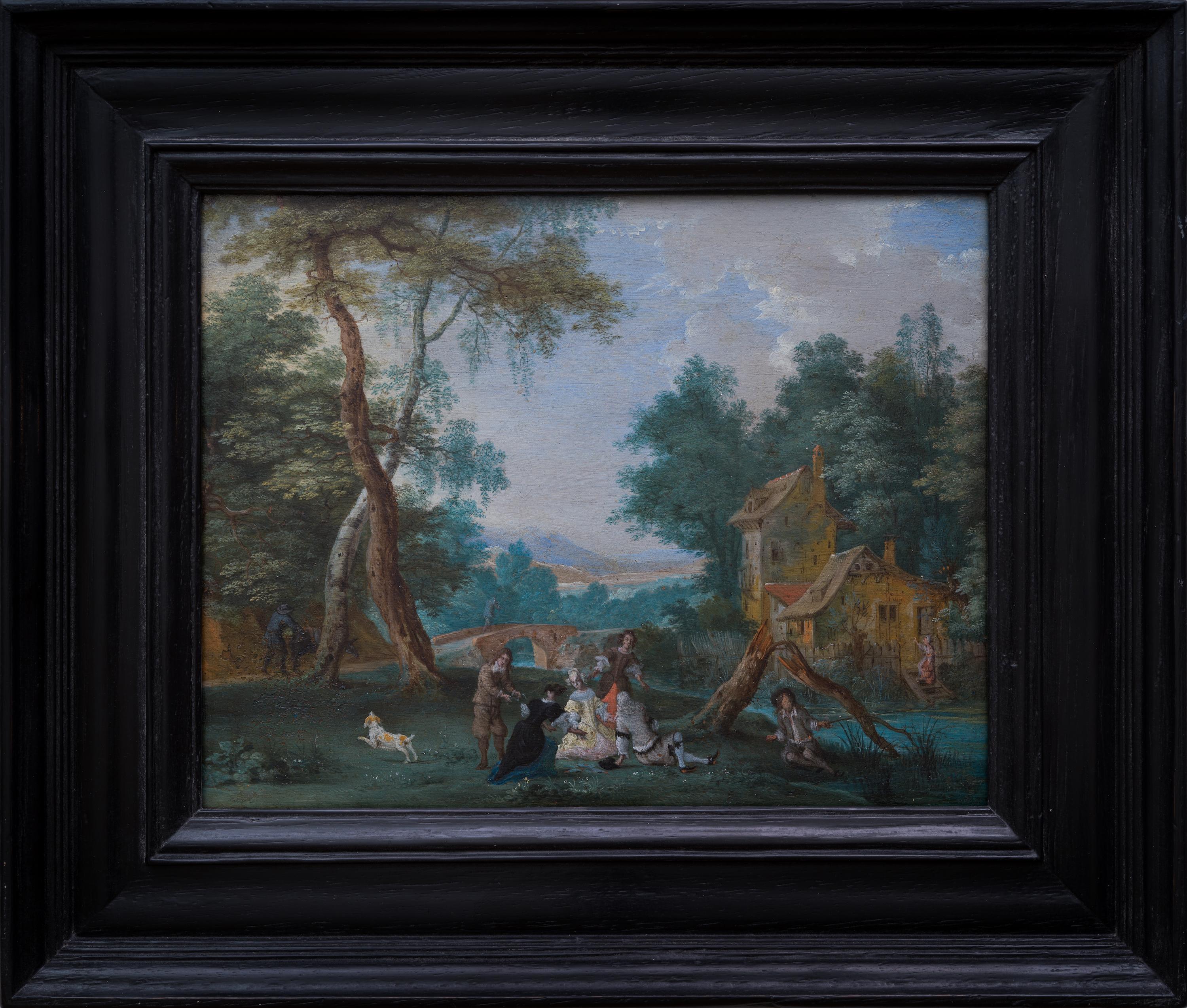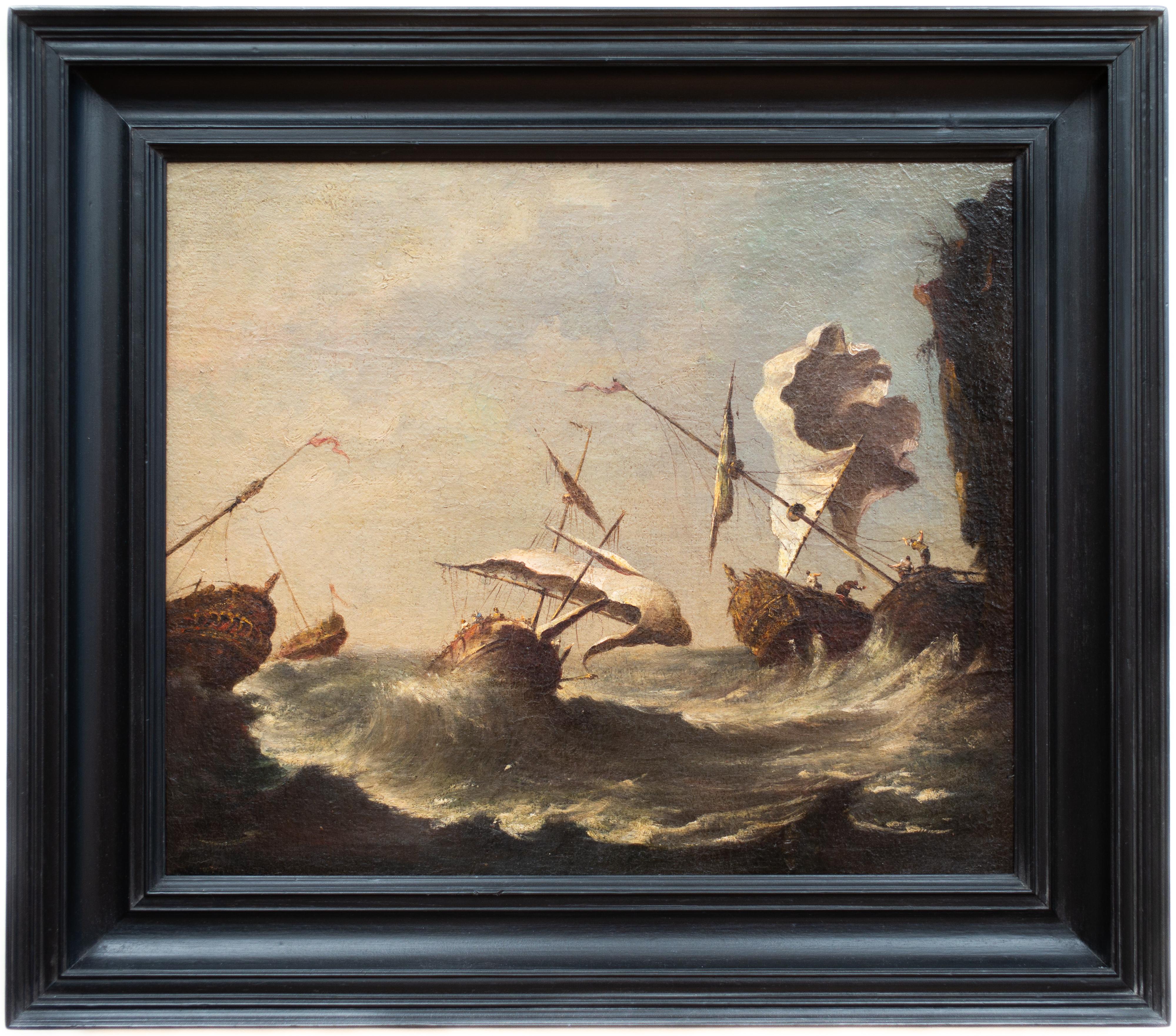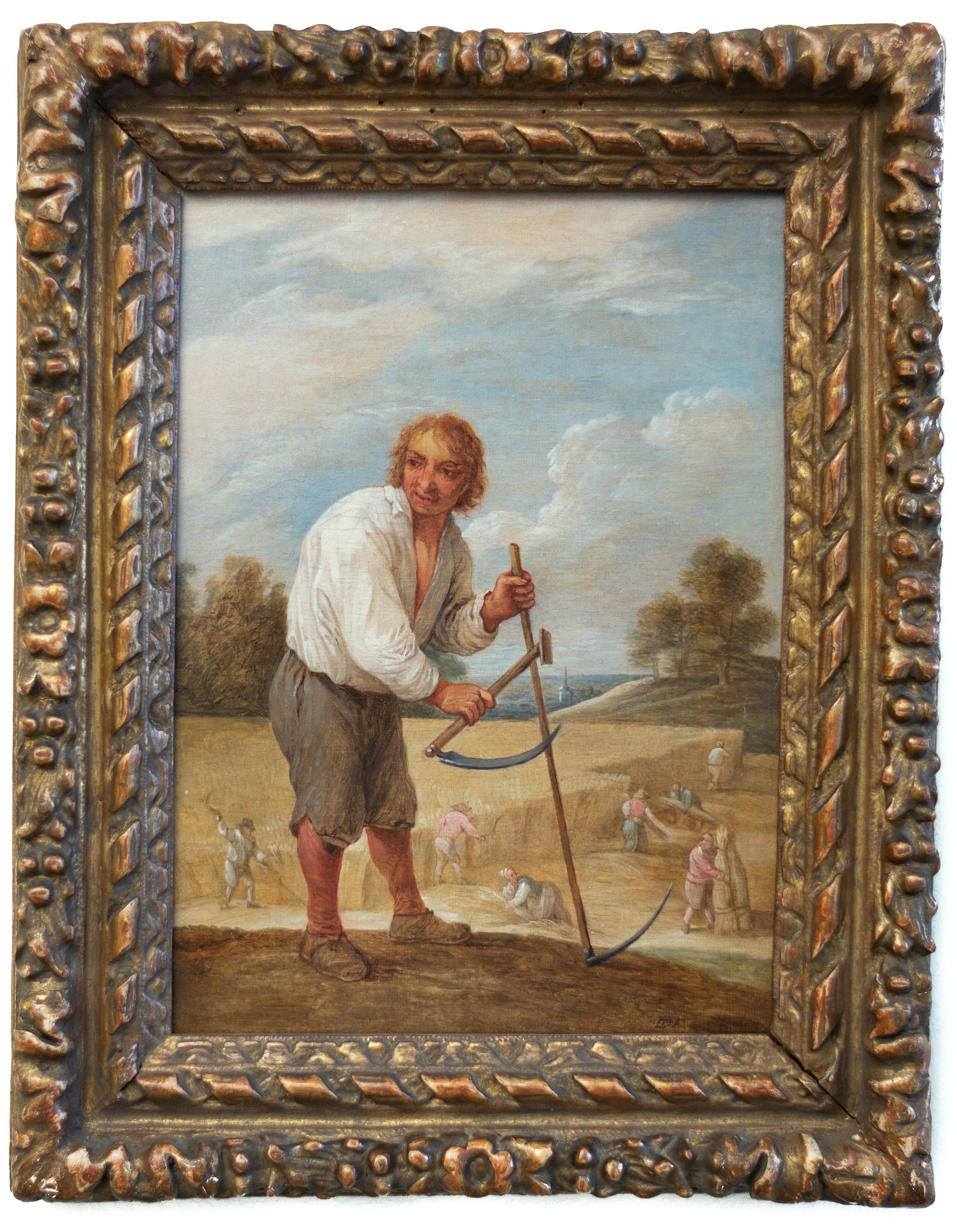Items Similar to 19th Century French Oil Painting Algeria - Capture of the Smalah of Abd el Kader
Want more images or videos?
Request additional images or videos from the seller
1 of 12
19th Century French Oil Painting Algeria - Capture of the Smalah of Abd el KaderCirca 1843
Circa 1843
About the Item
Circle of Emile Jean Horace Vernet (1789-1863)
The Capture of the Smalah of Abd el Kader
oil on canvas
48 x 55 1/2 in; 121 x 141 cms
(including magnificent contemporary carved frame)
Provenance
Private collection, United States
This important and impressive work records the historic skirmish in 1843 between a cavalry unit lead by the duc de Aumale and the Arab chief Abd el Kader during the French military campaign in Algeria. The painting is attributed to Horace Vernet, and relates closely to a major work of the same subject by Vernet now in the Musée de l'Histoire de France in Versailles.
The work is a classic example of French Orientalist painting from the mid-19th century, at a point when the taste for Oriental culture and history in Europe had reached an artistic intensity and commitment under the patronage of the French King Louis Philippe.
It is an exceptional example of Orientalist art, one linked with an important historic event, and a major royal commission.
Vernet and 'The Capture of the Smalah of Abd el Kader'
__________________________________________________________________
By the time Horace Vernet returned to Paris in 1835, following his duties at the helm of the Academie de France in Rome, he had achieved a status as the country's most eloquent military painter, and was to enjoy the immediate patronage of the king, Louis-Philippe himself (right). He was set up in an atelier in the Jeu de Paume at Versailles, where he worked for the next ten years.
The centrepiece of his work for the king was a series of monumental paintings for Versailles, glorifying France's military successes in North Africa. On his return from a trip to Russia in 1843, Vernet was handed the greatest of these commissions, to
record the victory of the duc d'Aumale, one of the king's sons, over the Arab chief Abd el Kader Abd ibn Muhyi al-Din, emir of Mascara, a charismatic 25- year-old who had assumed leadership over the divided tribes of North Africa.
On 16 May 1843 Aumale's force of 600 troops captured the Smalah, the emir's mobile encampment consisting of his family, servants and slaves, bodyguard and livestock. The Smalah had evaded the French for years, with constantly shifting tactics, and Aumale's cavalry charge, with a certain amount of luck, brought him some 3,000 prisoners. Abd el Kader escaped, and continued his offensive through nomadic tactics.
The vast canvas commissioned by the king to celebrate this (royal-led) victory dwarfed all other works at Versailles. Measuring 23 metres in length, and 5 metres in height, Vernet completed the 'Capture of the Smalah of Abd el Kader' in less than nine months and exhibited it at the Salon of 1845. It is an extraordinary panorama, surrounding the spectator with bewildering formations, adroitly conveying the confusion, horror and chaos of contemporary combat.
The present work derives its composition directly from elements of the primary canvas, though re-ordering episodes in order to formulate a cohesive tightened version of the narrative. Other qualities of the two works echo each other extremely closely, including the lustrous mode of paint application, and the strong, luminous colour values. Both works clearly also capture the extraordinary energy of the moment with a commitment to detail that is a hallmark of the artist's technique.
Horace Vernet
__________________________________________________________________
Vernet was born in Paris in 1789 and was predestined for art by family inheritance: the grandson of engraver Jean Moreau le Jeune (1741-1814) on his mother's side and, on his father's, of Joseph Vernet (1714-1789), France's foremost painter of land- and seascapes, he was trained by his father, Carle Vernet (1758-1836), the witty chronicler of the post- Revolutionary decades. A prodigy in his childhood, a professional in his teens, Horace was spurred by the financial requirements of an early marriage, producing a torrent of saleable work from his studio: caricatures, portraits, horses in the manner of Carle, landscapes in the manner of Joseph.
In the early years of the Restoration, his studio became the meeting place of artists and veterans openly hostile to the Bourbon government. He flaunted his cult of Napoleon and found a patron in Louis-Philippe, duc d'Orléans, head of the disaffected cadet branch of the dynasty. A resolute modernist, he befriended Gericault and was one of the pioneers of lithography. In a series of battle scenes from the Revolutionary and Napoleonic Wars painted for the duc d'Orléans in 1821-1826 (National Gallery, London), he gave a foretaste of what was to become his speciality.
The 1820s also saw Vernet make conciliatory gestures to the government, with practical results. He was made an officier of the Legion of Honor (1825), a member of the Institute (1826), and was appointed director of the French Academy in Rome (1829).
The Revolution in July 1830, which raised Louis-Philippe, Vernet's patron, to the throne, opened vast opportunities of official employment to him. The rapid flow of state commissions for battle pieces that now came his way taxed even his prodigious facility. Four very large canvases for the Galerie des Batailles (left) at Versailles, shown at the Salon of 1836, were followed by a second series in 1841. Accepting his calling as that of a painter of modern national subjects, specifically of scenes of combat, Vernet conceived of his work as a form of eyewitness reportage that required observation at the actual theatres of war. In five long visits to North Africa (1833, 1837, 1839-1840, 1845, 1853), he gathered on-the-spot documentation of the French conquests in Algiers and Morocco, material that he later worked up into wall-size canvases destined for Versailles.
The Universal Exposition of 1855, at which he was represented by twenty-four paintings, crowned his popular and official success. At the time of his death in 1863, Vernet, a member of thirty academies, was uncontestably France's most famous artist, admired and imitated throughout Europe and deeply embedded in popular culture.
- Creation Year:Circa 1843
- Dimensions:Height: 48 in (121.92 cm)Width: 55.5 in (140.97 cm)
- Medium:
- Movement & Style:
- Circle Of:Émile Jean-Horace Vernet (1789 - 1863)
- Period:
- Condition:
- Gallery Location:London, GB
- Reference Number:1stDibs: LU67337797102
About the Seller
5.0
Vetted Seller
These experienced sellers undergo a comprehensive evaluation by our team of in-house experts.
Established in 1990
1stDibs seller since 2017
40 sales on 1stDibs
Typical response time: <1 hour
- ShippingRetrieving quote...Ships From: London, United Kingdom
- Return PolicyA return for this item may be initiated within 1 day of delivery.
More From This SellerView All
- Grand 19th Century English Marine Painting in Stunning LightBy John Wilson EwbankLocated in London, GBJohn Wilson Ewbank (1799 - 1847) Shipping in the Harbour, South Shields Oil on canvas 39.5 x 58 inches unframed 47.75 x 66.5 inches framed Provenance: Christie's October 2002; Lot 11. Fine Art Society; Private Collection This marvellous up to scale Ewbank is full of light and warmth and almost certainly his greatest work of the sort rarely - if ever - seen on the market. John W. Ewbank (4 May 1799–28 November 1847), was an English-born landscape and marine painter largely operational from Scotland. The Humber river is a large tidal estuary on the east coast of Northern England. Life Ewbank was born at Darlington on 4 May 1799, the son of Michael Ewbank, an innkeeper. He was adopted as a child by a wealthy uncle who lived at Wycliffe, on the banks of the River Tees, in the North Riding of Yorkshire. Intended for the Roman Catholic priesthood, he was sent to Ushaw College, from which he absconded. In 1813 Ewbank was apprenticed to Thomas Coulson, an ornamental painter in Newcastle. In around 1816 he moved with Coulson to Edinburgh, where he had some lessons with Alexander Nasmyth. He found work both as a painter and a teacher. He was nominated in 1830 one of the foundation members of the Royal Scottish Academy. In 1833 he is listed as living at 7 Union Street on the eastern fringe of the New Town in Edinburgh. Works His sketches from nature were especially admired, and a series of 51 drawings of Edinburgh by him were engraved by W. H. Lizars for James Browne's Picturesque Views of Edinburgh (1825). He also made a reputation with cabinet pictures of banks of rivers, coast scenes, and marine subjects. As an illustrator he illustrated some early editions of Scott's Waverley Novels and one edition of Gilbert White...Category
19th Century Old Masters Figurative Paintings
MaterialsOil
- 18th Century English Oil Landscape Painting: Elegant Figures alongside River WyeBy Attributed to William MarlowLocated in London, GBAttributed to William Marlow (English, 1740-1813) Elegant Figures alongside the River Wye 1790 131 x 152 cm, inc. frame This quiet bucolic scene shows figur...Category
Late 18th Century Old Masters Figurative Paintings
MaterialsCanvas, Oil
- A Beautiful and Large Marine - A Ship in Two Positions Off DoverBy William John HugginsLocated in London, GBWilliam John Huggins (1781-1845) A Ship in Two Positions Off Dover oil on canvas Unsigned 33 x 45 inches, inc. frame William John Huggins, of wh...Category
19th Century Old Masters Figurative Paintings
MaterialsOil
- 18th Century Neoclassical Oil Painting of the Trojan War: Briseis & AchillesBy James ThornhillLocated in London, GBJames Thornhill (1674-1735) Oil on canvas 12 x 14 inches; 16 ½ x 18 ½ in. Inc. frame The subject matter and inclusion of herms on both sides shows the influence of Louis...Category
Early 18th Century Old Masters Figurative Paintings
MaterialsCanvas, Oil
- Monumental 17th Century Landscape Painting with Figures in an Arcadian settingLocated in London, GBEnormous 17th Century Italian landscape with figures in Arcadia. Unframed at present. Excellent condition.Category
17th Century Old Masters Landscape Paintings
MaterialsOil
- 17th Century Classical Oil Painting - Diana With Her Attendants in a GrottoBy Abraham van CuylenborchLocated in London, GBAbraham van CUYLENBROCH (1620-1658) Diana With Her Attendants in a Grotto 1651 signed oil on panel 12.2 in x 15.7 inches, inc. frame; 31 x 40 cm Provenance: Sale of Sotheby's Lo...Category
17th Century Old Masters Figurative Paintings
MaterialsOil
You May Also Like
- Stag Hunting in the Vicinity of Nuremberg by a German Artist Peter von BemmelLocated in PARIS, FRThis small landscape shows a hunting scene: two riders are chasing a stag with their dogs at the edge of a forest. Signed by Peter von Bemmel, it is typical of the production of this...Category
1720s Old Masters Landscape Paintings
MaterialsCopper
- 17th Century by Simone Cantarini Adoration of The Magi Painting Oil on CanvasLocated in Milano, LombardiaSimone Cantarini (Pesaro 1612 - Verona 1648) Adoration of the Magi Oil on paper applied to canvas, cm. 16,5 x 24 – with frame cm. 22 x 29 Antique sh...Category
Early 17th Century Old Masters Figurative Paintings
MaterialsCanvas, Cotton Canvas, Oil
- A 17th c. Italian school, Capriccio with the Colosseum, circle of V. CodazziLocated in PARIS, FRA capriccio with the Colosseum in Roma 17th century Italian school Circle of Viviano Codazzi (1604-1670) Oil on canvas Dimensions: h. 35.43 in, w. 51.18 in Modern 17th century style ...Category
17th Century Old Masters Landscape Paintings
MaterialsCanvas, Oil
- A Wooded Landscape With Riders, Attributed to Pieter Gysels, Oil on CopperLocated in Stockholm, SEPieter Gysels, also known as Peeter Gijsels, was a renowned Flemish painter who lived from 1621 to 1690/91. He was known for his landscapes, which often depicted idyllic scenes from nature, and his works are highly sought after by Old Master collectors. We are proud to offer a newly discovered pair of landscapes attributed to him; this one called "A Wooded Landscape With Riders" This stunning painting captures the beauty of a serene summer day in the countryside. In the foreground, we see a couple riding on horsebacks, enjoying the peaceful surroundings. The horses seems to be trotting gently, and the riders are relaxed, taking in the natural splendour around them. In the distance, we see several other figures, perhaps farmers or peasants, doing their daily tasks. We also see a small stream flowing through the landscape, with several small houses. And in the background, we see a beautiful wooded area with tall trees reaching up towards the sky. The attention to detail in this painting is truly remarkable. Gysels use of vibrant colours evoke the warmth and beauty and he skillfully captured the play of light on the landscape, creating a sense of depth and atmosphere. The detailing of the cottages, the colors, the use of big-leafed plants in the foreground, and the figure types are typical of his signature style. "A Wooded Landscape With Riders" is painted on copper, which gives the painting a unique luminosity and depth. The use of copper as a support for paintings was popular in the seventeenth century. We also have one more painting called "Wooded Landscape With an Elegant Company...Category
17th Century Old Masters Figurative Paintings
MaterialsCopper
- Shipping in Stormy Waters, Attributed to Italian Artist Francesco GuardiBy Francesco GuardiLocated in Stockholm, SEThe splendour of the tragic sea Francesco Guardi and maritime painting in Venetian art No Venetian painter was a stranger to the sea. After all, Venice was not only one of the most prominent ports of the Mediterranean, but indeed a city literally submerged in the ocean from time to time. Curiously however, the famous Venetian school of painting showed little interest in maritime motifs, favouring scenes from the iconic architecture of the city rather than seascapes. That is why this painting is a particularly interesting window into not only the painter Francesco Guardi himself – but to the significance of the element of water in art history, in absence as well as in the centre of attention. Whether it be calm, sunny days with stunning views of the palaces alongside the canals of Venice or – more rarely – stormy shipwrecking tragedies at sea, water as a unifying element is integral to the works of painter Francesco Guardi (1712–1793). During his lifetime, Venetian art saw many of its greatest triumphs with names like Tiepolo or Canaletto gaining international recognition and firmly establishing Venice as one of the most vibrant artistic communities of Europe. While the city itself already in the 18th century was something of an early tourist spot where aristocrats and high society visited on their grand tour or travels, the artists too contributed to the fame and their work spread the image of Venice as the city of romance and leisure to an international audience, many of whom could never visit in person. Still today, the iconic image of Venice with its whimsical array of palaces, churches and other historic buildings is much influenced by these artists, many of whom have stood the test of time like very well and remain some of the most beloved in all of art history. It was not primarily subtility, intellectual meanings or moral ideals that the Venetian art tried to capture; instead it was the sheer vibrancy of life and the fast-paced city with crumbling palaces and festive people that made this atmosphere so special. Of course, Venice could count painters in most genres among its residents, from portraiture to religious motifs, history painting and much else. Still, it is the Vedutas and views of the city that seems to have etched itself into our memory more than anything else, not least in the tradition of Canaletto who was perhaps the undisputed master of all Venetian painters. Born into his profession, Francesco lived and breathed painting all his life. His father, the painter Domenico Guardi (1678–1716) died when Francesco was just a small child, yet both he and his brothers Niccolò and Gian Antonio continued in their fathers’ footsteps. The Guardi family belonged to the nobility and originated from the mountainous area of Trentino, not far from the Alps. The brothers worked together on more challenging commissions and supported each other in the manner typical of family workshops or networks of artists. Their sister Maria Cecilia married no other than the artist Giovanni Battista Tiepolo himself, linking the family to the most renowned Venetian name of the time. During almost a decade, Guardi worked in the studio of Michele Giovanni Marieschi, sometimes simply known as Michiel, a painted similar in both style and motif. Canaletto is, however, the artist Guardi is most often compared to since they shared a mutual fascination for depicting the architecture and cityscape of Venice. During the course of his career, Guardi tried his hand in many different genres. He was as swift in painting landscapes, Vedutas of Venice, sacred motifs, interiors and architectural compositions as he was in a number of other motifs. His style is typical of the Venetian school but also distinct and personal once we look a little closer. There is an absolute certainty in the composition, the choice of which sometimes feels like that of a carefully calculated photograph – yet it is also very painterly, in the best sense of the word: fluid, bold, sensitive and full of character. The brushwork is rapid, intense, seemingly careless and extraordinarily minute at the same time; fresh and planned in a very enjoyable mixture. His interiors often capture the breath-taking spacious glamour of the palaces and all their exquisite decor. He usually constructed the motif through remarkably simple, almost spontaneous yet intuitively precise strokes and shapes. The result was a festive, high-spirited atmospheric quality, far away from the sterile and exact likeness that other painters fell victim to when trying to copy Canaletto. The painting here has nothing of the city of Venice in it. On the contrary, we seem to be transported far away into the solitary ocean, with no architecture, nothing to hold on to – only the roaring sea and the dangerous cliffs upon which the ships are just moments away from being crushed upon. It is a maritime composition evoking both Flemish and Italian precursors, in the proud tradition of maritime painting that for centuries formed a crucial part of our visual culture. This genre of painting is today curiously overlooked, compared to how esteemed and meaningful it was when our relationship to the sea was far more natural than it is today. When both people and goods travelled by water, and many nations and cities – Venice among them – depended entirely on sea fare, the existential connection to the ocean was much more natural and integrated into the imagination. The schools and traditions of maritime art are as manifold as there are countries connected to the sea, and all reflect the need to process the dangers and wonders of the ocean. It could symbolize opportunity, the exciting prospects of a new countries and adventures, prospering trade, beautiful scenery as well as war and tragedy, loss of life, danger and doom. To say that water is ambivalent in nature is an understatement, and these many layers were something that artists explored in the most wondrous ways. Perhaps it takes a bit more time for the modern eye to identify the different nuances and qualities of historic maritime paintings, they may on first impression seem hard to differentiate from each other. But when allowing these motifs to unfold and tell stories of the sea in both fiction and reality – or somewhere in between – we are awarded with an understanding of how the oceans truly built our world. In Guardi’s interpretation, we see an almost theatrically arranged shipwrecking scene. No less than five ships are depicted right in the moment of utter disaster. Caught in a violent storm, the waves have driven them to a shore of sharp cliffs and if not swallowed by the waves, crushing against the cliffs seems to be the only outcome. The large wooden ships are impressively decorated with elaborate sculpture, and in fact relics already during Guardi’s lifetime. They are in fact typical of Dutch and Flemish 17th century ships, giving us a clue to where he got the inspiration from. Guardi must have seen examples of Flemish maritime art, that made him curious about these particular motifs. One is reminded of Flemish painters like Willem van de Velde and Ludolf Backhuysen, and this very painting has indeed been mistakenly attributed to Matthieu van Plattenberg...Category
18th Century Old Masters Landscape Paintings
MaterialsCanvas, Oil
- Peasants in a Cornfield (Boer in het veld) by David Teniers the YoungerBy David Teniers the YoungerLocated in Stockholm, SERemembering the magic of everyday life moments in the art of David Teniers: The art of David Teniers the Younger (1610–1690) coincided with the heyday of the Flemish Baroque and captured a great variety of motifs of his time. In this painting of a seemingly simple peasant scene lies keys to understanding both the imaginative mind of Teniers as well as why this time period produced some of the most iconic works in all of art history. As indicated by the name, Teniers was more or less born into his profession. As the son of David Teniers the elder, himself a painter who studied under Rubens, the younger David received training in art from a very young age and had no less than three brothers who also became painters. Because of his father’s frequent financial failures that even at times saw him imprisoned, David the younger helped to rescue the family from ruin through painting copies of old masters. Essentially, the young Teniers was confronted with painting as both a passion and creative expression as well as a necessity during difficult times, an experience that would shape much of his capacity and sensitivity in his coming life. Despite the hardships, the talent and determination of Teniers was recognized and quickly expanded his possibilities. He had already spent time in France and possibly also England when he was hired by his father’s former teacher Rubens to help with a prestigious commission with mythological paintings, now considered lost, for Philip IV the king Spain. In 1644–54 Teniers was appointed dean of the Antwerp Guild of Saint Luke, manifesting his esteemed position within the artistic community. A few years afterwards he took an important step when relocating to Brussels, where Teniers yet again found new career opportunities that would prove to be very successful. As the keeper of the collections of Archduke Leopold Wilhelm, a role similar to what we now refer to as an art advisor, Teniers purchased hundreds of important artworks that manifested the prominent status of the Archduke’s collection while at the same time providing an unusual access to inspiration and knowledge for Teniers himself. Since he kept on painting during the same time, his creative scope must have seemed almost bewildering in the great variety of images and stories that he surrounded himself with. Regardless of how glamorous and culturally stimulating the career of Teniers was, he was as open to the charm and existential importance of everyday life as he was to works of great masters and luxurious collectibles. In his impressive repertoire of genres with everything from exquisite royal portraits, interiors, landscapes and history paintings he always added something new and inventive, highlighting the possibilities of art and importance of an experimental and intuitive mind. It is difficult to single out one aspect or genre to summarize his legacy, since it lies much more in the broad virtuosity across many motifs, although he is particularly remembered for farm scenes and meticulously depicted interiors where other paintings and artworks are captured with an astonishing precision. However, the fact that he is still today one of the most known and celebrated names of the Dutch Golden Age is a proof to the magic of his work, which continues to spark dialogue and wonder in the contemporary viewer of his works. The farm boy in the field in this painting, which likely dates to the mature part of his career, is a wonderful entry into the mind of Teniers. In the tightly cropped motif, we see him standing right in the middle of the busy harvest when men, women and everyone capable were sent out in the field to collect the crop that formed the very core of their diet and survival. In the background we see a fresh blue sky interspersed with skillfully painted clouds, some trees reaching their autumnal colours and in the far distance the glimpse of a small church and village. The presence of a church in a landscape, so typical of Dutch art, served both a symbolic and visual function as a representation of faith while at the same time defining scale and distance. In the field, the work is in full action with the farmers spread out in various positions, all in the midst of hard and sweaty labour. While they are portrayed as having nothing else than the work on their mind, our farm boy seems to have his attention directed elsewhere. Standing there with his white, half open shirt, flowy curls and strong, sturdy body; his gaze is directed away, out of the picture and the scythes in his hands. He looks almost smirking, expressed with tremendous subtlety in the slight smile of his lips and big eyes, being just in the middle of losing focus on the work. What is it that steals his attention? What has he seen, or realized, or felt – to break him free of the arduous task of harvesting, if but for a moment? Here starts the wondering and the questions that are the hallmark of a great piece of art. Instead of explicitly locking in the motif in overly clear symbolism Teniers has chosen an open ended, subtle yet striking moment for us to consider. While it of course can be related to numerous other farm scene depictions of this time, and clever usages of gazes and real-life scenes to underscore various moral or symbolic meanings, the painting can be much more of a contemplation than an explanation or illustration. The ordinary nature and understated yet emotionally textured composition of the motif gives greater space for our own reactions and thoughts. Has he seen a pretty farm girl just passing by? Is he fed up with the farm life, joyously dreaming away for a minute, imagining another future? Or is he simply in need of distraction, looking away and ready for anything that can steal his attention? One quality that never seem to have escaped Teniers was that of curiosity. During all of his career he constantly investigated, expanded and experimented with not only the style and technique of painting, but with the vision of art itself. Being credited with more or less introducing farm motifs for a broader audience not only tells us of his ability to understand the demand for different motifs, but the sensitivity to transform seemingly ordinary parts of life into deep aesthetic experiences, far beyond their expected reach. The farm boy in this painting is, of course, exactly that. But with the help of one smirk the entire picture is charged with a different energy, awakening many contrasts and relationships between the calm landscape, the hard work and his own breach of effectivity, holding sharp scythes while thinking or seeing something else. It is no wonder Teniers chose to work with farm scenes as a way of investigating these intricate and delicate plays on expectations and surprises, clarity and ambivalence. It invites us to an appreciation of human everyday life that connects us with the people of 17th century...Category
Late 17th Century Old Masters Landscape Paintings
MaterialsCanvas, Oil
